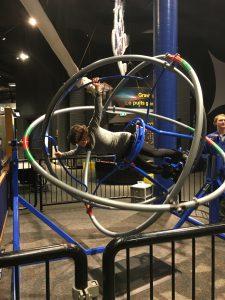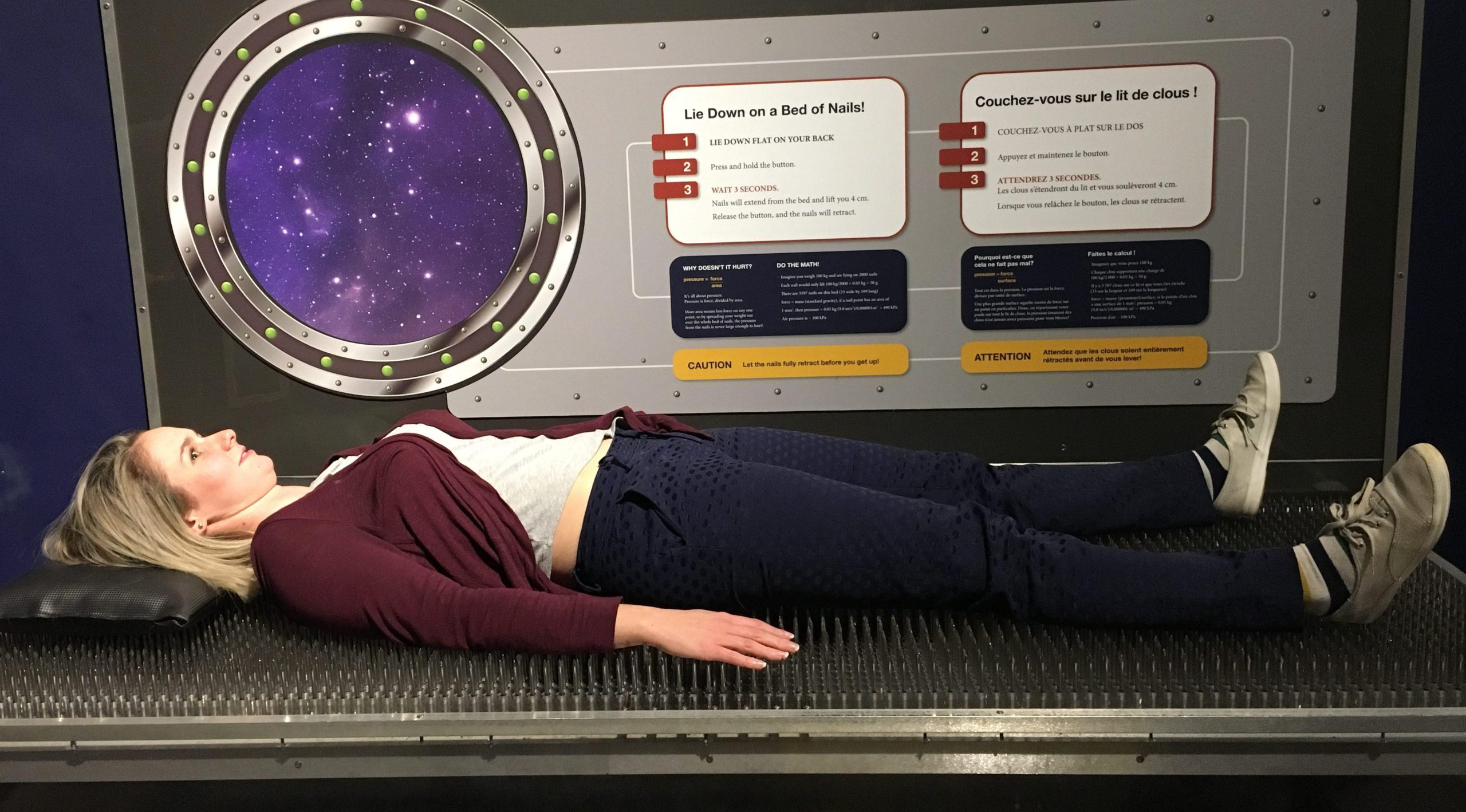Virtually every year, our entire team participates in the Association of Canadian Ergonomists conference. Last week, the conference was in Sudbury. It’s not easy to justify closing down our office for almost a week for all of us to attend, but we do. Here’s why…
- Teambuilding. This is the only time when our team has a chance to spend this much time together, not working. We played at Science North (see Josie on the bed of nails, above), met for breakfast, and cheered each other on at our presentations. We had fun.
- Networking. Very few of our clients are at these workshops, so we’re not selling. But it’s really great to connect with other ergonomists, and to catch up with ergonomists who used to work with us.
- Professional development. We learn so much by hearing about case studies and research, and we come back to work charged up with ideas for our clients. It’s amazing how much we are able to transfer from one industry to another! (We are always on the lookout for bits of wisdom that we can use right away.)
- Presentation skills. Josie and Kristina both presented at the conference this year, and we were there to cheer them on. Creating these presentations, and practicing them in the car on the 5 hour drive to Sudbury, is valuable experience!
- Supporting our president (and Association). Karen is the ACE president this year, so we naturally needed to demonstrate support for the many, many hours that she has voluntarily toiled in this capacity. (Much clapping, and many celebratory toasts!)
More specifically, here are some of the gold nuggets of research and case studies that we mined at the conference. (See what I did there…Sudbury….mine…never-mine.)
- “Hybrid seating” (a new term to describe sit/stand stools) creates shear between the buttocks and cushion, and between the feet and floor, which creates an energy cost. If we’re aiming for a 135 degree thigh/torso angle to take the load off the back, perhaps reclined is the next thing to try. (Michal Glinka)
- When you evaluate new footwear for a specific task, you should consider comfort, mobility, stability, and perceived exertion. But at the end of the day, if boots are not waterproof (and the job involves stepping through water), or if they won’t stand up to wear, they won’t have long-term acceptance. (Corey Bouwmeester)
- Are autonomous tractors in the near future of farming in Canada? How exciting! This seems like a logical way to address whole body vibration and MSDs associated with sedentary sitting and climbing on/off heavy equipment, and also to optimise productivity. But it might not be good news for traditional farmers. Lots of other fascinating research on ingress and egress was presented by Catherine Trask from the Ergo Lab at the University of Saskatchewan.
- When you post bulletin board content (as we do, weekly, for our on-site ergo clients), you should change up the colour and “look” so people notice that it’s been changed.
- Ryan Smiley, one of our ergonomists from a decade or so ago, presented a project that he has been leading in BC, which is resulting in an upgrade to power stretchers and power loaders for all ambulances. I can’t think of a better way to spend $20M. (Not sarcasm…I mean it….what an amazing investment!)
- Dr. Neil Mansfield, in his keynote address, descri
 bed how the history of “wearables” has always revolved around fashion and function, from Egyptian symbols of status and occupation from 3000 years ago, to the 1980’s Casio calculator watch. The conference included other sessions where the future of wearables in ergo was also discussed. On that note, I wonder how many steps my wearable would have tracked, if Karen had worn it on the gyroscope at Science North? She really had that thing rolling!
bed how the history of “wearables” has always revolved around fashion and function, from Egyptian symbols of status and occupation from 3000 years ago, to the 1980’s Casio calculator watch. The conference included other sessions where the future of wearables in ergo was also discussed. On that note, I wonder how many steps my wearable would have tracked, if Karen had worn it on the gyroscope at Science North? She really had that thing rolling! - Digital Human Modelling was also a hot topic – Allison Stephens reminded the audience that using DHM allows us to talk the language of engineers, which is exactly what we’ve been finding with our clients. DHM is much more sensitive to the “what if” questions that engineers want us to answer.
- I found Amy Doan’s presentation on medical device user interface and blame fascinating. Did you know that it’s common for nurses to have to re-start IV machines when they encounter navigation errors? This causes delays in treatment, and may cause the nurse to forget to re-enter information that was entered on the first attempt. The blame for these errors typically falls on the nurses, or their training. Manufacturers who program the software are not getting feedback so they can correct these design problems. Isn’t it time that ergonomists should have a role in designing user interfaces that fit humans? That’s what we’re here for!


